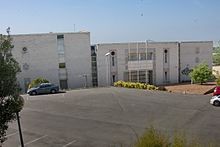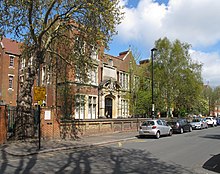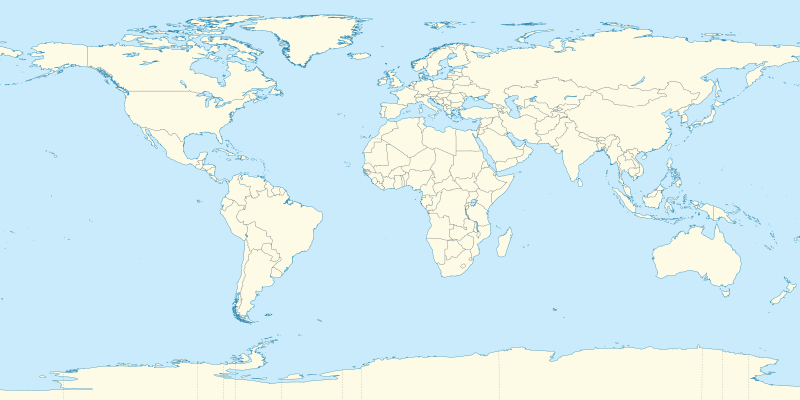Nihonjin gakkō
You can help expand this article with text translated from the corresponding article in Japanese. (November 2010) Click [show] for important translation instructions.
|
This article needs additional citations for verification. (September 2008) |

Nihonjin gakkō (日本人学校, lit. School for Japanese people), also called Japanese school, is a full-day school outside
The schools offer exactly the same
They are accredited by Japan's
Every school hires teachers from Japan on a two- to three-year assignment, but they also hire people from the local community as Japanese-speaking teachers, English and other language instructors, administrative assistants, gardeners, janitors and security guards.
Nihonjin gakkō serve elementary school and junior high school.[5] One nihonjin gakkō, Shanghai Japanese School, has a senior high school program.[6]
Schools that partially offer the nihonjin gakkō's curriculum after school hours or on weekends are sometimes called Japanese schools, too, but strictly speaking they are categorized as
History

Some of the nihonjin gakkō in Asia have a long history, originally established as public schools in the Japan-occupied territories in Thailand, Philippines, and Taiwan.[citation needed]
As Japan recovered after

The
In 1971, there were 22 nihonjin gakkō worldwide.

In the early 1980s, 40% of Japanese national children living in Europe attended nihonjin gakkō, while almost 95% of Japanese national children living abroad in Asia attended nihonjin gakkō.[9]
Many Japanese parents abroad sent their children to Japan to attend high school after they completed the junior high school abroad, or leaving the children behind, so they could become accustomed to the difficult Japanese university entrance systems. Toshio Iwasaki, the editor of the
By 1991 many overseas Japanese high schools were accepting students who were resident in Japan, and some wealthier families in Japan chose to send their children to Japanese schools abroad instead of Japanese schools in Japan.[12]
While Japan was experiencing a major
With its rapidly growing economy, China is an exception. Schools in Beijing, Shanghai and Hong Kong[citation needed] have been expanding and new schools had founded in Dalian, Guangzhou, Tianjin, Qingdao, Suzhou since 1991.[citation needed]
By 2004 there were 83 Japanese day schools in 50 countries.[8]
Characteristics
This section needs expansion. You can help by adding to it. (January 2015) |

Nihonjin gakkō use Japanese as their language of instruction. The curriculum is approved by the Japanese Ministry of Education, Culture, Sports, Science and Technology (MEXT) so that students may easily adjust upon returning to Japan.[8] For foreign language classes, each school usually teaches English and, if different, a major local language of the country.[8][13] Most nihonjin gakkō do not admit people lacking Japanese citizenship.[8] This practice differs from those of American and British international schools, which do admit students of other nationalities.[14] Nihonjin gakkō usually use the Japanese academic calendar instead of those of their host countries.[15]
Tendencies
This section needs additional citations for verification. (January 2015) |
As of 2005–2007, parents of Japanese nationality residing in the United States and Europe,[8] as well as other industrialized and developed regions,[16] generally prefer local schools over nihonjin gakkō, while Japanese parents in Asia and the Middle East prefer nihonjin gakkō.[8]
In 2003 11,579 Japanese students living in Asia (outside Japan) attended full-time Japanese schools, making up more than 70% of the Japanese students in Asia.[17] In Oceania, 194 Japanese pupils attended full-time Japanese schools, making up 7.7% of the total Japanese students in Oceania.[18] In North America there were 502 students at full-time Japanese schools, making up 2.4% of Japanese pupils on that continent.[17] As of 2007, there were a total of three nihonjin gakkō on the U.S. mainland recognized by MEXT.[19]
Since the early 1990s, more parents have chosen a local school or an international school over nihonjin gakkō.[citation needed] Reasons include:
- The parents prefer for their children to receive education in English;
- Nihonjin gakkō have only Shiritsu zaigai kyōiku shisetsu (私立在外教育施設), Japanese boarding schools worldwide.[citation needed]
- The parents' desire to acculturate their children;
- Many private and public Japanese schools have become flexible and accept expatriate students via a separate admissions system, or by offering exams in English.
Locations

Nihonjin gakkō tend to be in the following types of areas in the world:
- Those with a large Japanese temporary resident population, such as London or New York City.
- Those where English is not the official language, such as Düsseldorf, São Paulo, Mexico City, Lima, Dubai, Shanghai and Kuala Lumpur.
As of October 2006:[20]
Map
Asia (except the Middle East)
- Bangladesh
- Japanese School Dhaka
- Cambodia
- Mainland China
- Beijing Japanese School
- Dalian Japanese School
- Guangzhou Japanese School
- Hangzhou Japanese School (杭州日本人学校)
- Qingdao Japanese School (青島日本人学校)
- Shanghai Japanese School
- Shenzhen Japanese School
- Suzhou Japanese School
- Tianjin Japanese School (天津日本人学校)
- Hong Kong
- India
- Indonesia
- Bandung Japanese School
- Jakarta Japanese School
- Surabaya Japanese School (スラバヤ日本人学校)
- Malaysia
- The Japanese School of Kuala Lumpur
- The Japanese School of Johor (ジョホール日本人学校, Malay: Sekolah Jepun(Johor))
- Kota Kinabalu Japanese School (コタキナバル日本人学校)
- Penang Japanese School (ペナン日本人学校, Malay: Sekolah Jepun P. Pinang)
- The Japanese School of Perak (ペラ州日本人学校, Malay: Sekolah Jepun Perak)
- Myanmar
- Pakistan
- Islamabad Japanese School
- Karachi Japanese School
- Philippines
- Republic of China (Taiwan)
- Singapore
- The Japanese School in Singapore
- Other schools catering to Japanese are
- South Korea
- Sri Lanka
- Thailand
- Vietnam
Middle East (not including Africa)
- Bahrain
- Egypt
- See Africa
- Iran
- Japanese School in Tehran
- Qatar
- The Japan School of Doha
- Saudi Arabia
- Jeddah Japanese School[citation needed]
- Riyadh Japanese School
- Turkey
- United Arab Emirates
- Japanese School in Abu Dhabi
- Japanese School in Dubai





